Hospitality is in Aashim Bajaj’s blood. His family own restaurants and hotels in India, on mainland Europe and, of course, here in Ireland. When it was time for Aashim to go to college, he chose to go to a prestigious hospitality school in Switzerland. Today, he lives in Ashbourne, Co Meath, and operates The Cinnamon Garden – a restaurant which, from day one of its existence, has specialised in authentic Indian cuisine.
“My mom was vegetarian and my dad ate meat, so it wasn’t always easy growing up, but dad managed a few things and so did mom – with a compromise,” he laughs, as we dig into a feast of freshly fried aloo poori with chutneys and pickles.

Indian cuisine gets its colour from the array of spices used - not from artificial colours \ Philip Doyle
“Both of my parents are excellent chefs,” he adds. “As a kid, I grew up in the restaurants. I knew from an early age that I wanted to study hospitality.”
Since 2009, Aashim has been on a mission to bring real Indian cuisine to Ireland and convert those who might be partial to more inauthentic offerings on the market.
“The first few years of The Cinnamon Garden were very difficult,” he admits. “I opened this restaurant saying: ‘This is Indian food. You need to change your palate to enjoy my food.’ It took me one or two years to succeed, and it was the hardest time of my life. People would come to me and say: ‘Your chicken tikka is not red!’ India is colourful, but we never add artificial colour to our food.”
Aashim takes great pride in his food and his culture. By sharing these recipes, he hopes to help make Indian cuisine a bit more accessible for people all over Ireland.
“Indian food is all about layers of balanced flavour,” he says with a smile. “I want these recipes to be accessible. Every supermarket now has their spice sections and if you don’t have something on the recipe list, it isn’t the end of the world.”
Serves two
Masala chai is a milky, spicy tea that is famous in India but is gaining popularity globally. The primary distinction between chai and masala chai is that masala chai contains spices, whereas chai consists only of milk and tea.
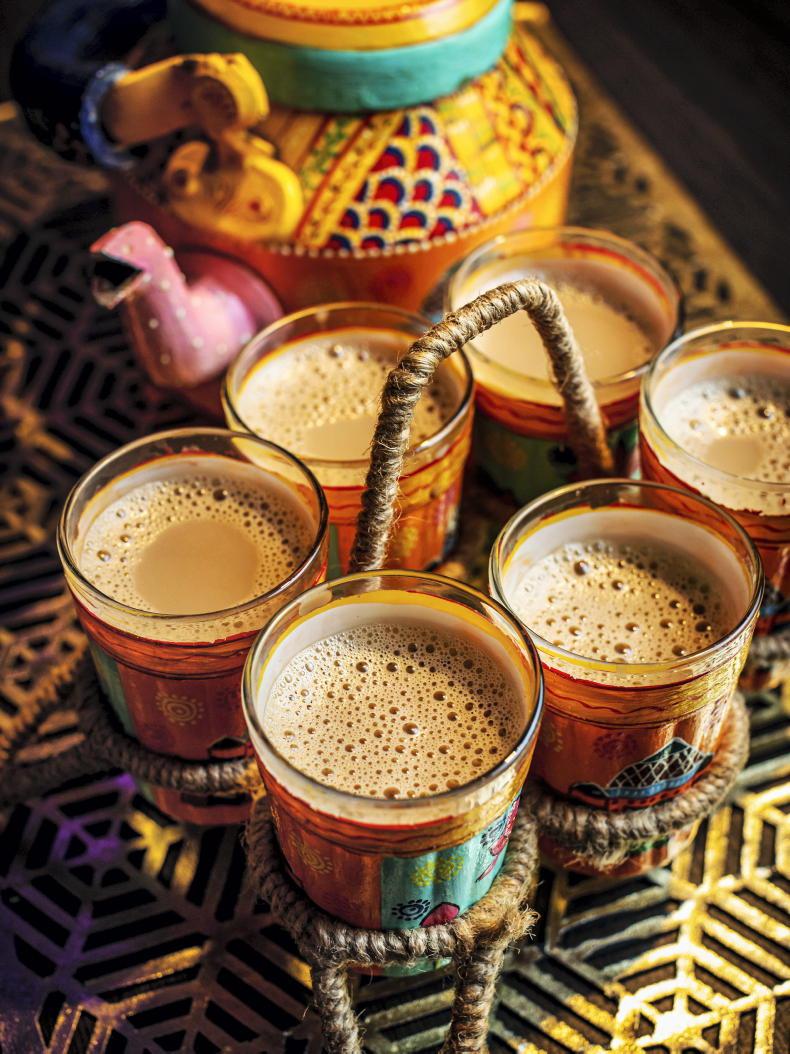
Masala Chai is deliciously spiced while chai is simply tea with milk \ Philip Doyle
Ingredients
Whole spices: ½ cinnamon stick, 2-3 cloves, 2-3 pieces of lightly crushed cardamom, 3-4 black peppercorns and a sprinkling of fennel seeds
Two regular tea bags (use decaf before bed)
500ml water
100ml milk
3 tbsp sugar or sweetener of choice
1-inch piece fresh ginger, grated
1 Pound the dry spices with a mortar and pestle into a coarse powder (crushing the spices helps release the flavour and creates a stronger infusion, resulting in a drink that packs a punch).
2 Combine the crushed spices with 500ml of water and the ginger in a pot and boil for approximately 15 minutes. If gingery chai isn’t your thing, slice the ginger instead of grating it and/or decrease the quantity to your taste.
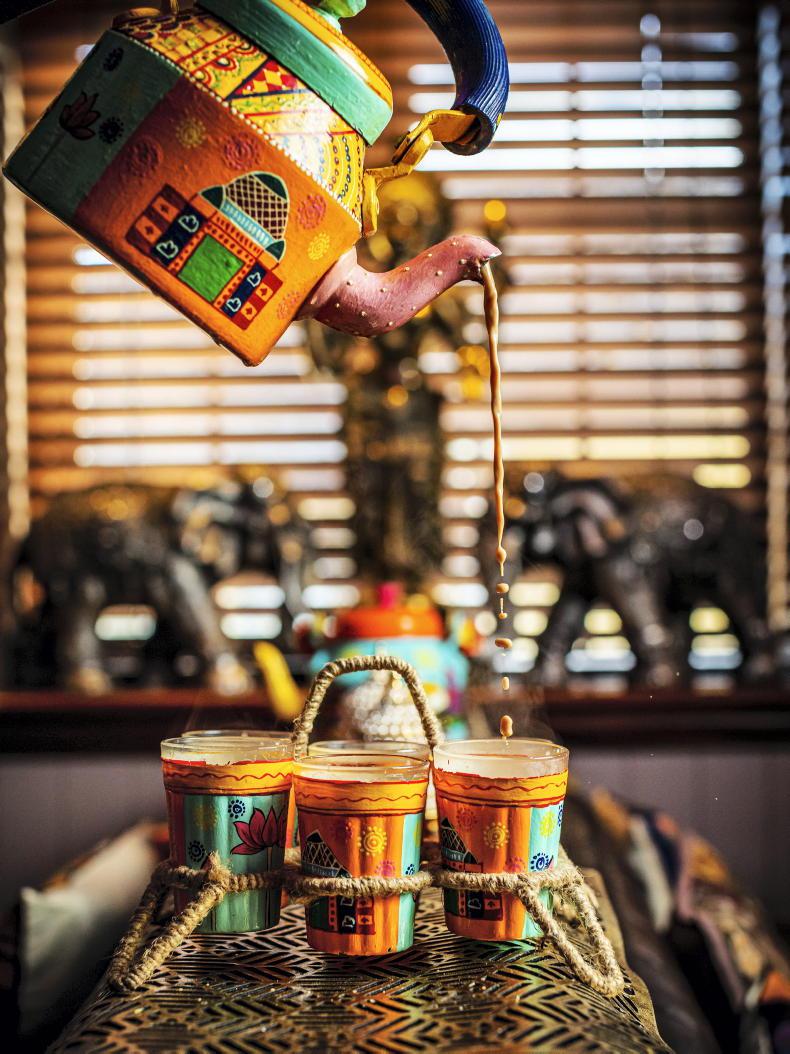
Masala Chai is gaining global popularity thanks to its warm and comforting flavour profile \ Philip Doyle
3 Add two tea bags to the mixture and simmer for five minutes. Then, add the milk. Simmer gently until the milk starts to boil to the top of the pot.
4 Using a sieve to catch the tea bags, spices and ginger, pour the masala chai into your favourite mug and enjoy it hot.
Serves two
This sweet, creamy treat is usually reserved for special trips to your local Indian restaurant, but now you can easily make mango lassi at home to enjoy any time you like. You can adjust the amount of honey or sugar in this recipe to sweeten it to your personal taste.
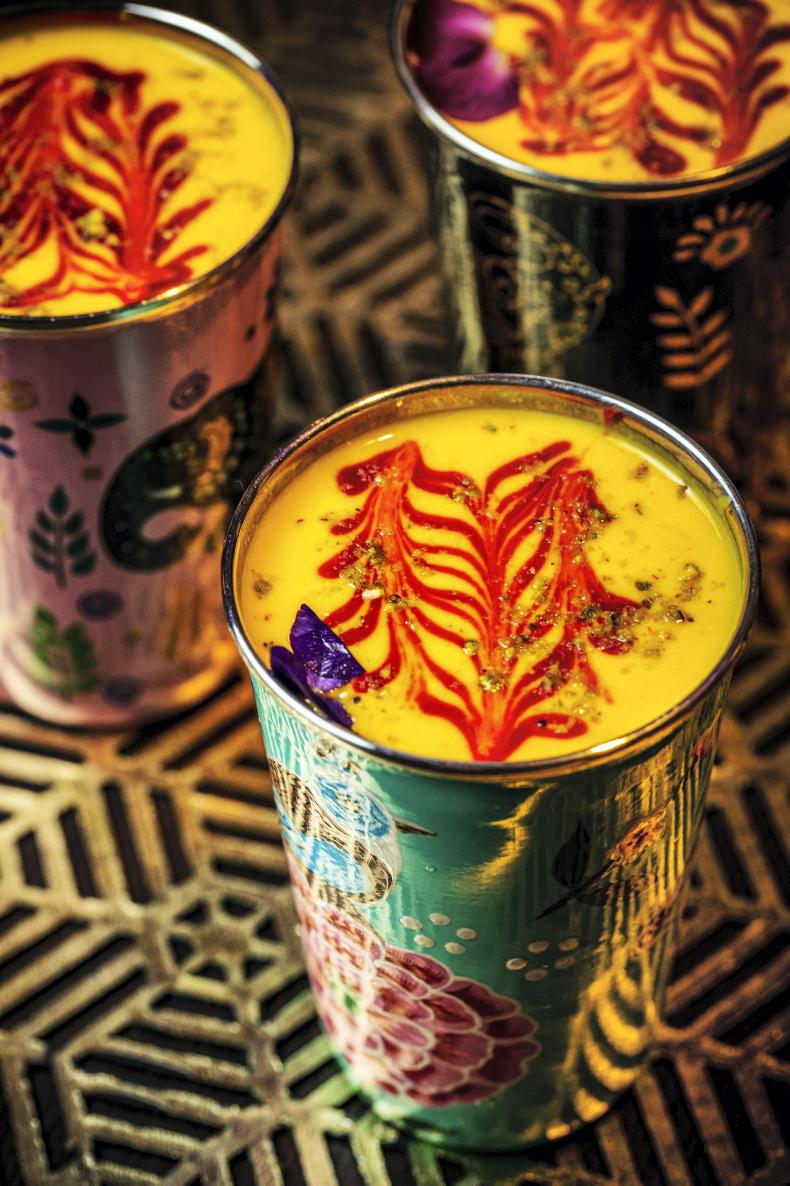
Mango lassi requires few ingredients and comes together quickly \ Philip Doyle
Ingredients
100ml mango pulp
300ml yoghurt
150ml milk
2 tbsp honey or sugar (optional)
½ teaspoon green cardamom powder
Diced fresh mango (optional)
1 Add all ingredients (except the diced fresh mango) to a large bowl or blender and mix or blend until smooth and well-combined. Pour over ice and, if you like, top with diced fresh mango. Serve immediately or keep the mixture chilled until ready to use (give it a whisk again before serving).
Serves two
Ingredients
1 tsp chilli powder
3 tsp ground turmeric
2 tsp salt
2 tbsp vegetable oil
3 tsp onion seeds
3 tsp cumin seeds
3 tsp ground coriander seeds
1 onion, finely chopped
2 cloves garlic, thinly sliced
3-4 whole tomatoes, roughly chopped
1 tbsp fresh ginger, grated
3 green chillies, finely chopped
One red bell pepper, thinly sliced
One yellow bell pepper, thinly sliced
Juice of one lemon
200g fresh prawns, tails and veins removed
For garnish:
Fresh coriander, finely chopped
Green chilli, finely chopped
Can you handle a bit of heat? This prawn jalfrezi is spicy, full of fresh veggies and, most importantly, packed full of flavour. See Ciara’s wine pairing suggestion on pages 30-31.

Prawn Jalfrezi. \ Philip Doyle
1 In a bowl, combine the chilli powder, turmeric and salt, then add the cleaned prawns and toss to coat.
2 Heat the oil on medium-low heat and add the cumin seeds, coriander seeds and onion seeds. Add the onion and garlic and saute for five minutes, until softened. Add the fresh tomatoes, ginger, red and yellow bell peppers and the green chilli.
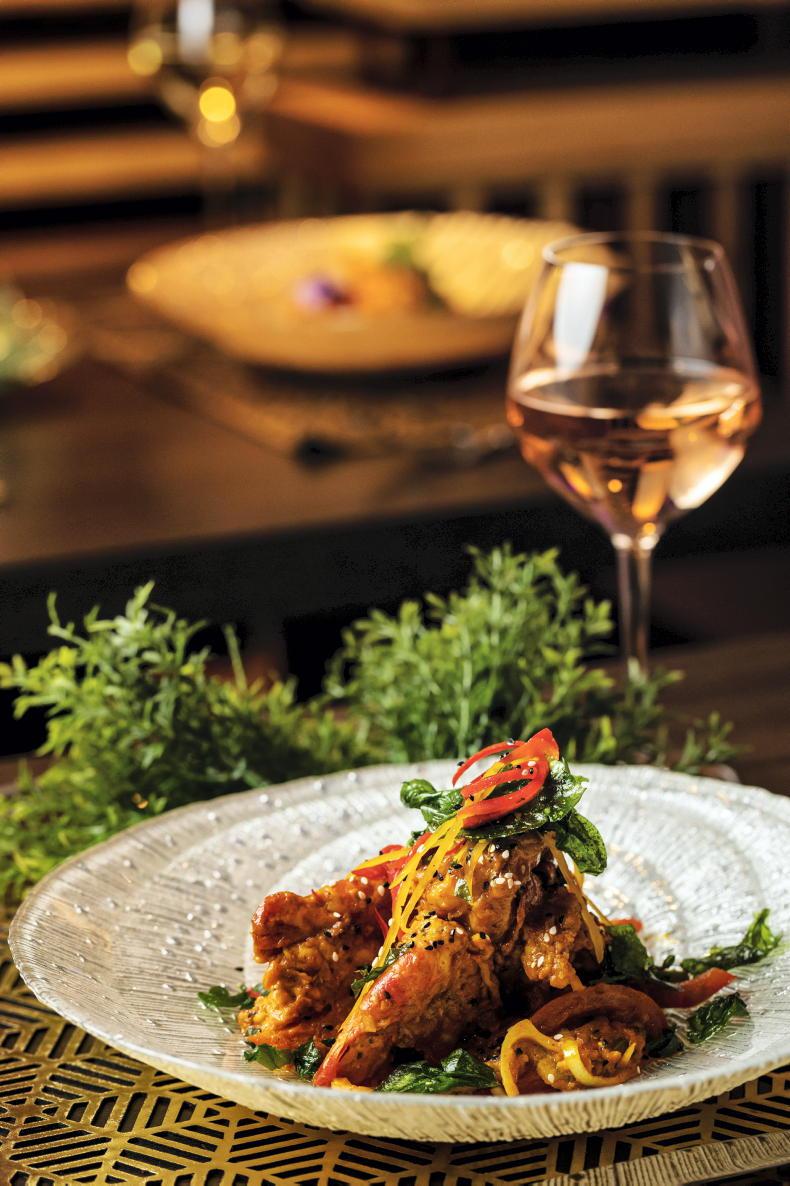
Prawn Jalfrezi. \ Philip Doyle
3 Add the prawns to the pan and cook for 10 minutes, or until golden brown and well cooked. Add the lemon juice and give everything a good mix.
4 Spoon the prawn jalfrezi onto plates to serve. Serve with rice, naan, then garnish with chopped coriander and green chilli.
Serves two
If you’re tired of the same old roasted lamb for Easter dinner, this could make for a very interesting alternative. Tender, fall-off-the-bone lamb cooked in a medley of Indian spices – what’s not to love?
4 tbsp natural yoghurt
1 tbsp ground cumin
2 tsp Kashmiri chilli powder
2 tsp salt
1 tsp turmeric
4 tbsp garam masala
2 lamb shanks
4 tbsp oil
4 large onions, thinly sliced
½ tbsp garlic paste
½ tbsp ginger paste
500g tomato passata
3 dried red chilli peppers
3 green cardamom pods, crushed
3 black cardamom pods, crushed
2 bay leaves
2 small cinnamon stick

Slow-cooked lamb shank. \ Philip Doyle
1 In a large mixing bowl, combine the yoghurt, cumin, Kashmiri chilli powder, turmeric, salt, garam masala and the lamb shanks, then coat the meat with the mixture. Cover and refrigerate for at least four hours or overnight, if you have the time.
2 Preheat the oven to 120°C.
3 To a large roasting tin, add the oil, sliced onions, garlic and ginger paste, cinnamon sticks, both types of cardamom, bay leaves, dried chilli and tomato passata. Mix well, then add the marinated lamb shanks and mix again. Roast in the preheated oven for 30 minutes.
4 Remove the lamb shank and puree the sauce in the roasting tin (you can remove any big bits of spice before blending and then add them back in). Add the lamb shanks back in, increase the temperature to 160°C and slow cook the lamb shank for about 1.5 hours.
5 Once cooked, let the lamb rest for 30 minutes (or allow it to cool fully before reheating; this can be made a day or two ahead). Serve with naan and rice.
Serves two
Butter chicken is one of the most popular dishes served in Indian restaurants worldwide. Aashim’s version is possibly one of the tastiest you’ll ever try; with its aromatic chunks of chicken tikka coated in an exquisitely creamy, savoury sauce.
Ingredients
500g skinless boneless chicken thighs
For the marinade:
Juice of ½ lemon
2 tsp garam masala
1 tsp green cardamom powder
½ tbsp ginger paste
½ tbsp garlic paste
2 tsp Kashmiri red chilli powder
150g natural yoghurt
¼ tsp turmeric
2 tsp cumin
2 tsp salt
For the butter sauce:
2 tbsp butter
1 large onion, finely chopped
3 garlic cloves, crushed
3 green chillis, finely chopped
Thumb-sized piece of ginger, grated
1 tsp garam masala
500g tomato passata
100g cashew nuts, soaked in boiled water for 10 minutes and blended
100g fresh cream
1-2 green chillis, finely chopped (for garnish); fresh coriander, finely chopped (for garnish)

Butter Chicken \ Philip Doyle
1 Make the chicken tikka: place the boneless chicken thigh pieces into a bowl with lemon, garam masala, green cardamom powder, ginger paste, garlic paste, Kashmiri red chilli powder, yoghurt, turmeric cumin and salt. Mix together, cover and marinate in the fridge for two to three hours.
2 Sear off in a frying pan, or grill in the oven or on the barbecue for 10-12 minutes, until cooked through.
3 Make the butter sauce: heat the butter in a large, heavy-bottomed pot. Add the onion, garlic, green chilli, ginger, garam masaka and ground fenugreek. Cook slowly for at least 10 minutes on medium heat, or until completely soft.
4 Add the tomato passata and cashew puree to this mixture and heat gently for an additional five minutes until aromatic, and then add the cooked pieces of chicken tikka.

Butter Chicken \ Philip Doyle
5 Add the cream and two tbsp butter, continue to cook for another five minutes. To finish, garnish with fresh coriander and chopped green chilli.
6 Serve immediately with rice or naan bread.
Serves two
We know that duck and fruit are the best of friends when it comes to flavour pairings, and in this recipe things aren’t any different. The sweet mango and coconut pairs beautifully with the fatty, flavourful duck breast.

Mango Duck \ Philip Doyle
Ingredients
2 large duck breasts
1 tsp plus 1 tbsp vegetable oil
½ tsp onion seeds
6 curry leaves
120ml mango pulp
5ml mango chutney
5ml tamarind chutney
100ml coconut milk
A small handful of fresh mint leaves, roughly chopped
½ tsp green cardamom powder
Pinch of ground cinnamon
2 tsp salt
1 Prepare your duck breasts: using a sharp knife, lightly score the skin. Heat the oil over low to medium heat and sear the duck breast, skin side down, for about five minutes (until the skin is crisp) and then flip and cook for another few minutes until medium rare on the inside (if using a meat thermometer, the inside of the duck for medium rare should be around 60°C).
2 Make the sauce: using a clean saucepan, add one tablespoon of vegetable oil. Add the onion seed and curry leaves to this and cook for one to two minutes.
3 Add the mango pulp, mango chutney, tamarind chutney and coconut milk. Mix and bring to a simmer. Cook until slightly thickened, about seven to 10 minutes.
4 Add the green cardamom powder, a pinch of cinnamon and the fresh mint leaves, then season with salt to taste.
5 To serve: add a ladleful of sauce to a serving bowl and place the duck breast on top. On the side, serve pulao rice (see below).
Serves two
1 tbsp vegetable oil
2 tsp cumin seeds
2 cinnamon sticks
4 cardamom pods, crushed
2 whole cloves
2 bay leaves
1 tsp ground turmeric
½ tsp salt
300g basmati rice
600ml boiling water

Pulao Rice \ Philip Doyle
Aromatic, fluffy and the perfect rice to soak up a delicious curry sauce; this pulao rice comes together easily and pairs with any of the curry recipes in this spread.
1 In a pot with a tight-fitting lid, heat the oil on medium-low heat and add the cumin seeds, cinnamon sticks, cloves, cardamom, turmeric and bay leaves.
2 Add 600ml of water and bring to a boil.
3 Add the basmati rice. Cover and reduce the heat to low. Cook the rice for 15 minutes.
4 Turn off the heat entirely, but keep the lid on. Steam the rice for a further five minutes, then remove the lid and fluff the rice with a fork. You can remove the spices at this stage.
5 Serve hot with your favourite curry.
Serves four
If you enjoy naan or chapatis with your curry, then you will love these puffy, fried breads that are known as poori. They are served with a savoury vegetable gravy, which is known as sabzi. This could be a great starter for an Indian-focused meal, though traditionally aloo poori is eaten as a snack or for breakfast.
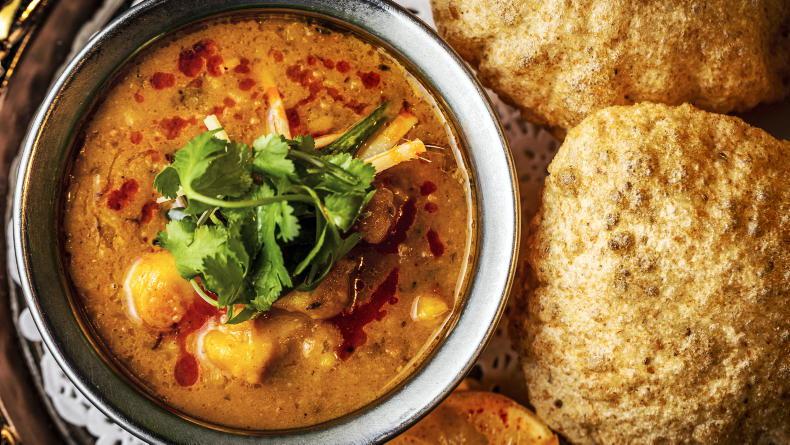
Aloo Poori is delicious any time of the day, but is traditionally eaten as a snack or for breakfast \ Philip Doyle
Ingredients
For the poori
330g plain flour
2 tsp vegetable oil
½ tsp ajwain seeds, crushed
½ tsp salt
250ml water
200ml vegetable oil (for frying)
For the aloo sabzi:
2 tbsp vegetable or rapeseed oil
1 tbsp ground cumin
3 dried red chillis
¼ tsp hing (also called asafoetida)
1 tbsp fresh grated root ginger
2 tbsp minced garlic
3 large tomatoes, chopped
5 green chillis, finely chopped
1 tbsp ground coriander
½ tsp ground turmeric
1 tbsp Kashmiri red chilli powder
1 tbsp dried fenugreek leaves
2 tsp salt
1 tsp garam masala
½ tsp fennel seed powder (also called saunf)
¼ tsp dry mango powder (also called amchur)
500ml water
4 large potatoes, peeled, cubed and parboiled
Freshly chopped coriander (for garnish)

The poori is the bread, and the aloo sabzi is the vegetable "gravy" for dipping \ Philip Doyle
1 Make the poori dough: add the flour to a large mixing bowl. Add the oil, ajwain and salt. Mix well.
2 Add 125ml of the water (half) and gently begin kneading the dough – it will be shaggy, at first.
3 Add half of the remaining water and continue kneading the dough. You may not need to add any more water, if you are able to continue kneading the dough until it is smooth, elastic and can be shaped into a ball. If the dough is still too dry, add the remaining water (bit by bit), until the dough is smooth and elastic, but not sticky.
4 Once the dough is shaped into a ball, leave it in the bowl, cover it with a clean tea towel and set it aside to rest for at least 10 minutes.
5 Divide the dough into eight equal-sized portions and roll them into balls.
6 Heat the oil in a heavy bottomed pot on medium-high heat for about 10 minutes, or until the oil reaches 190°C (if using a thermometer).
7 With your hands or a mini rolling pin, flatten each ball into a disc shape. You don’t want it to be paper thin, but around 1 or 1.5cm in thickness.
8 Slip the disc into the preheated oil. It will sink to the bottom before rising to the surface.
9 Using a ladle or large spoon, repeatedly coat the top of the poori with hot oil as it fries as this will help it inflate.
10 Once the poori is puffed up on one side, gently flip it over and then cook on the other side until completely golden brown in colour.
11 Remove any excess oil from the poori once cooked by letting it drain on a platter lined with kitchen towel. Repeat with the remaining dough balls.
12 Make the aloo sabzi: in a large saucepan over medium heat, add the oil, cumin, dried red chilli, hing, ginger and garlic. Cook, stirring constantly, for one to two minutes.
13 Add the chopped tomatoes and green chillis. Stir occasionally and cook gently, over medium heat, until this mixture thickens.
14 Once this happens, add your dried spices: the coriander, turmeric, Kashmiri red chilli powder, dried fenugreek, salt, garam masala, dried fennel powder and dried mango powder. Mix well.
15 Add in the chopped, parboiled potatoes and water. Bring to a simmer, cover the pan and cook over medium heat for five minutes.
16 Garnish with fresh chopped coriander and serve hot alongside the warm, fresh pooris with pickles and chutneys. J
Read more
Causeway Coastal Christmas
Easter brunch has nothing on Jane Russell
Hospitality is in Aashim Bajaj’s blood. His family own restaurants and hotels in India, on mainland Europe and, of course, here in Ireland. When it was time for Aashim to go to college, he chose to go to a prestigious hospitality school in Switzerland. Today, he lives in Ashbourne, Co Meath, and operates The Cinnamon Garden – a restaurant which, from day one of its existence, has specialised in authentic Indian cuisine.
“My mom was vegetarian and my dad ate meat, so it wasn’t always easy growing up, but dad managed a few things and so did mom – with a compromise,” he laughs, as we dig into a feast of freshly fried aloo poori with chutneys and pickles.

Indian cuisine gets its colour from the array of spices used - not from artificial colours \ Philip Doyle
“Both of my parents are excellent chefs,” he adds. “As a kid, I grew up in the restaurants. I knew from an early age that I wanted to study hospitality.”
Since 2009, Aashim has been on a mission to bring real Indian cuisine to Ireland and convert those who might be partial to more inauthentic offerings on the market.
“The first few years of The Cinnamon Garden were very difficult,” he admits. “I opened this restaurant saying: ‘This is Indian food. You need to change your palate to enjoy my food.’ It took me one or two years to succeed, and it was the hardest time of my life. People would come to me and say: ‘Your chicken tikka is not red!’ India is colourful, but we never add artificial colour to our food.”
Aashim takes great pride in his food and his culture. By sharing these recipes, he hopes to help make Indian cuisine a bit more accessible for people all over Ireland.
“Indian food is all about layers of balanced flavour,” he says with a smile. “I want these recipes to be accessible. Every supermarket now has their spice sections and if you don’t have something on the recipe list, it isn’t the end of the world.”
Serves two
Masala chai is a milky, spicy tea that is famous in India but is gaining popularity globally. The primary distinction between chai and masala chai is that masala chai contains spices, whereas chai consists only of milk and tea.

Masala Chai is deliciously spiced while chai is simply tea with milk \ Philip Doyle
Ingredients
Whole spices: ½ cinnamon stick, 2-3 cloves, 2-3 pieces of lightly crushed cardamom, 3-4 black peppercorns and a sprinkling of fennel seeds
Two regular tea bags (use decaf before bed)
500ml water
100ml milk
3 tbsp sugar or sweetener of choice
1-inch piece fresh ginger, grated
1 Pound the dry spices with a mortar and pestle into a coarse powder (crushing the spices helps release the flavour and creates a stronger infusion, resulting in a drink that packs a punch).
2 Combine the crushed spices with 500ml of water and the ginger in a pot and boil for approximately 15 minutes. If gingery chai isn’t your thing, slice the ginger instead of grating it and/or decrease the quantity to your taste.

Masala Chai is gaining global popularity thanks to its warm and comforting flavour profile \ Philip Doyle
3 Add two tea bags to the mixture and simmer for five minutes. Then, add the milk. Simmer gently until the milk starts to boil to the top of the pot.
4 Using a sieve to catch the tea bags, spices and ginger, pour the masala chai into your favourite mug and enjoy it hot.
Serves two
This sweet, creamy treat is usually reserved for special trips to your local Indian restaurant, but now you can easily make mango lassi at home to enjoy any time you like. You can adjust the amount of honey or sugar in this recipe to sweeten it to your personal taste.

Mango lassi requires few ingredients and comes together quickly \ Philip Doyle
Ingredients
100ml mango pulp
300ml yoghurt
150ml milk
2 tbsp honey or sugar (optional)
½ teaspoon green cardamom powder
Diced fresh mango (optional)
1 Add all ingredients (except the diced fresh mango) to a large bowl or blender and mix or blend until smooth and well-combined. Pour over ice and, if you like, top with diced fresh mango. Serve immediately or keep the mixture chilled until ready to use (give it a whisk again before serving).
Serves two
Ingredients
1 tsp chilli powder
3 tsp ground turmeric
2 tsp salt
2 tbsp vegetable oil
3 tsp onion seeds
3 tsp cumin seeds
3 tsp ground coriander seeds
1 onion, finely chopped
2 cloves garlic, thinly sliced
3-4 whole tomatoes, roughly chopped
1 tbsp fresh ginger, grated
3 green chillies, finely chopped
One red bell pepper, thinly sliced
One yellow bell pepper, thinly sliced
Juice of one lemon
200g fresh prawns, tails and veins removed
For garnish:
Fresh coriander, finely chopped
Green chilli, finely chopped
Can you handle a bit of heat? This prawn jalfrezi is spicy, full of fresh veggies and, most importantly, packed full of flavour. See Ciara’s wine pairing suggestion on pages 30-31.

Prawn Jalfrezi. \ Philip Doyle
1 In a bowl, combine the chilli powder, turmeric and salt, then add the cleaned prawns and toss to coat.
2 Heat the oil on medium-low heat and add the cumin seeds, coriander seeds and onion seeds. Add the onion and garlic and saute for five minutes, until softened. Add the fresh tomatoes, ginger, red and yellow bell peppers and the green chilli.

Prawn Jalfrezi. \ Philip Doyle
3 Add the prawns to the pan and cook for 10 minutes, or until golden brown and well cooked. Add the lemon juice and give everything a good mix.
4 Spoon the prawn jalfrezi onto plates to serve. Serve with rice, naan, then garnish with chopped coriander and green chilli.
Serves two
If you’re tired of the same old roasted lamb for Easter dinner, this could make for a very interesting alternative. Tender, fall-off-the-bone lamb cooked in a medley of Indian spices – what’s not to love?
4 tbsp natural yoghurt
1 tbsp ground cumin
2 tsp Kashmiri chilli powder
2 tsp salt
1 tsp turmeric
4 tbsp garam masala
2 lamb shanks
4 tbsp oil
4 large onions, thinly sliced
½ tbsp garlic paste
½ tbsp ginger paste
500g tomato passata
3 dried red chilli peppers
3 green cardamom pods, crushed
3 black cardamom pods, crushed
2 bay leaves
2 small cinnamon stick

Slow-cooked lamb shank. \ Philip Doyle
1 In a large mixing bowl, combine the yoghurt, cumin, Kashmiri chilli powder, turmeric, salt, garam masala and the lamb shanks, then coat the meat with the mixture. Cover and refrigerate for at least four hours or overnight, if you have the time.
2 Preheat the oven to 120°C.
3 To a large roasting tin, add the oil, sliced onions, garlic and ginger paste, cinnamon sticks, both types of cardamom, bay leaves, dried chilli and tomato passata. Mix well, then add the marinated lamb shanks and mix again. Roast in the preheated oven for 30 minutes.
4 Remove the lamb shank and puree the sauce in the roasting tin (you can remove any big bits of spice before blending and then add them back in). Add the lamb shanks back in, increase the temperature to 160°C and slow cook the lamb shank for about 1.5 hours.
5 Once cooked, let the lamb rest for 30 minutes (or allow it to cool fully before reheating; this can be made a day or two ahead). Serve with naan and rice.
Serves two
Butter chicken is one of the most popular dishes served in Indian restaurants worldwide. Aashim’s version is possibly one of the tastiest you’ll ever try; with its aromatic chunks of chicken tikka coated in an exquisitely creamy, savoury sauce.
Ingredients
500g skinless boneless chicken thighs
For the marinade:
Juice of ½ lemon
2 tsp garam masala
1 tsp green cardamom powder
½ tbsp ginger paste
½ tbsp garlic paste
2 tsp Kashmiri red chilli powder
150g natural yoghurt
¼ tsp turmeric
2 tsp cumin
2 tsp salt
For the butter sauce:
2 tbsp butter
1 large onion, finely chopped
3 garlic cloves, crushed
3 green chillis, finely chopped
Thumb-sized piece of ginger, grated
1 tsp garam masala
500g tomato passata
100g cashew nuts, soaked in boiled water for 10 minutes and blended
100g fresh cream
1-2 green chillis, finely chopped (for garnish); fresh coriander, finely chopped (for garnish)

Butter Chicken \ Philip Doyle
1 Make the chicken tikka: place the boneless chicken thigh pieces into a bowl with lemon, garam masala, green cardamom powder, ginger paste, garlic paste, Kashmiri red chilli powder, yoghurt, turmeric cumin and salt. Mix together, cover and marinate in the fridge for two to three hours.
2 Sear off in a frying pan, or grill in the oven or on the barbecue for 10-12 minutes, until cooked through.
3 Make the butter sauce: heat the butter in a large, heavy-bottomed pot. Add the onion, garlic, green chilli, ginger, garam masaka and ground fenugreek. Cook slowly for at least 10 minutes on medium heat, or until completely soft.
4 Add the tomato passata and cashew puree to this mixture and heat gently for an additional five minutes until aromatic, and then add the cooked pieces of chicken tikka.

Butter Chicken \ Philip Doyle
5 Add the cream and two tbsp butter, continue to cook for another five minutes. To finish, garnish with fresh coriander and chopped green chilli.
6 Serve immediately with rice or naan bread.
Serves two
We know that duck and fruit are the best of friends when it comes to flavour pairings, and in this recipe things aren’t any different. The sweet mango and coconut pairs beautifully with the fatty, flavourful duck breast.

Mango Duck \ Philip Doyle
Ingredients
2 large duck breasts
1 tsp plus 1 tbsp vegetable oil
½ tsp onion seeds
6 curry leaves
120ml mango pulp
5ml mango chutney
5ml tamarind chutney
100ml coconut milk
A small handful of fresh mint leaves, roughly chopped
½ tsp green cardamom powder
Pinch of ground cinnamon
2 tsp salt
1 Prepare your duck breasts: using a sharp knife, lightly score the skin. Heat the oil over low to medium heat and sear the duck breast, skin side down, for about five minutes (until the skin is crisp) and then flip and cook for another few minutes until medium rare on the inside (if using a meat thermometer, the inside of the duck for medium rare should be around 60°C).
2 Make the sauce: using a clean saucepan, add one tablespoon of vegetable oil. Add the onion seed and curry leaves to this and cook for one to two minutes.
3 Add the mango pulp, mango chutney, tamarind chutney and coconut milk. Mix and bring to a simmer. Cook until slightly thickened, about seven to 10 minutes.
4 Add the green cardamom powder, a pinch of cinnamon and the fresh mint leaves, then season with salt to taste.
5 To serve: add a ladleful of sauce to a serving bowl and place the duck breast on top. On the side, serve pulao rice (see below).
Serves two
1 tbsp vegetable oil
2 tsp cumin seeds
2 cinnamon sticks
4 cardamom pods, crushed
2 whole cloves
2 bay leaves
1 tsp ground turmeric
½ tsp salt
300g basmati rice
600ml boiling water

Pulao Rice \ Philip Doyle
Aromatic, fluffy and the perfect rice to soak up a delicious curry sauce; this pulao rice comes together easily and pairs with any of the curry recipes in this spread.
1 In a pot with a tight-fitting lid, heat the oil on medium-low heat and add the cumin seeds, cinnamon sticks, cloves, cardamom, turmeric and bay leaves.
2 Add 600ml of water and bring to a boil.
3 Add the basmati rice. Cover and reduce the heat to low. Cook the rice for 15 minutes.
4 Turn off the heat entirely, but keep the lid on. Steam the rice for a further five minutes, then remove the lid and fluff the rice with a fork. You can remove the spices at this stage.
5 Serve hot with your favourite curry.
Serves four
If you enjoy naan or chapatis with your curry, then you will love these puffy, fried breads that are known as poori. They are served with a savoury vegetable gravy, which is known as sabzi. This could be a great starter for an Indian-focused meal, though traditionally aloo poori is eaten as a snack or for breakfast.

Aloo Poori is delicious any time of the day, but is traditionally eaten as a snack or for breakfast \ Philip Doyle
Ingredients
For the poori
330g plain flour
2 tsp vegetable oil
½ tsp ajwain seeds, crushed
½ tsp salt
250ml water
200ml vegetable oil (for frying)
For the aloo sabzi:
2 tbsp vegetable or rapeseed oil
1 tbsp ground cumin
3 dried red chillis
¼ tsp hing (also called asafoetida)
1 tbsp fresh grated root ginger
2 tbsp minced garlic
3 large tomatoes, chopped
5 green chillis, finely chopped
1 tbsp ground coriander
½ tsp ground turmeric
1 tbsp Kashmiri red chilli powder
1 tbsp dried fenugreek leaves
2 tsp salt
1 tsp garam masala
½ tsp fennel seed powder (also called saunf)
¼ tsp dry mango powder (also called amchur)
500ml water
4 large potatoes, peeled, cubed and parboiled
Freshly chopped coriander (for garnish)

The poori is the bread, and the aloo sabzi is the vegetable "gravy" for dipping \ Philip Doyle
1 Make the poori dough: add the flour to a large mixing bowl. Add the oil, ajwain and salt. Mix well.
2 Add 125ml of the water (half) and gently begin kneading the dough – it will be shaggy, at first.
3 Add half of the remaining water and continue kneading the dough. You may not need to add any more water, if you are able to continue kneading the dough until it is smooth, elastic and can be shaped into a ball. If the dough is still too dry, add the remaining water (bit by bit), until the dough is smooth and elastic, but not sticky.
4 Once the dough is shaped into a ball, leave it in the bowl, cover it with a clean tea towel and set it aside to rest for at least 10 minutes.
5 Divide the dough into eight equal-sized portions and roll them into balls.
6 Heat the oil in a heavy bottomed pot on medium-high heat for about 10 minutes, or until the oil reaches 190°C (if using a thermometer).
7 With your hands or a mini rolling pin, flatten each ball into a disc shape. You don’t want it to be paper thin, but around 1 or 1.5cm in thickness.
8 Slip the disc into the preheated oil. It will sink to the bottom before rising to the surface.
9 Using a ladle or large spoon, repeatedly coat the top of the poori with hot oil as it fries as this will help it inflate.
10 Once the poori is puffed up on one side, gently flip it over and then cook on the other side until completely golden brown in colour.
11 Remove any excess oil from the poori once cooked by letting it drain on a platter lined with kitchen towel. Repeat with the remaining dough balls.
12 Make the aloo sabzi: in a large saucepan over medium heat, add the oil, cumin, dried red chilli, hing, ginger and garlic. Cook, stirring constantly, for one to two minutes.
13 Add the chopped tomatoes and green chillis. Stir occasionally and cook gently, over medium heat, until this mixture thickens.
14 Once this happens, add your dried spices: the coriander, turmeric, Kashmiri red chilli powder, dried fenugreek, salt, garam masala, dried fennel powder and dried mango powder. Mix well.
15 Add in the chopped, parboiled potatoes and water. Bring to a simmer, cover the pan and cook over medium heat for five minutes.
16 Garnish with fresh chopped coriander and serve hot alongside the warm, fresh pooris with pickles and chutneys. J
Read more
Causeway Coastal Christmas
Easter brunch has nothing on Jane Russell




















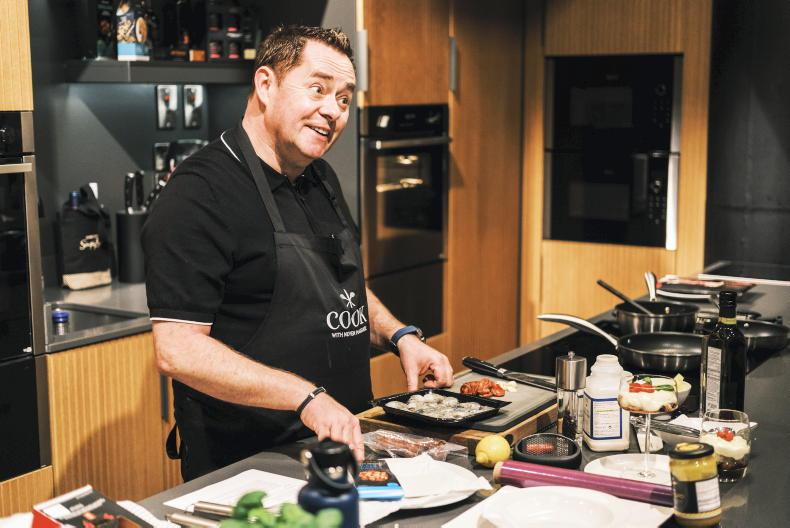
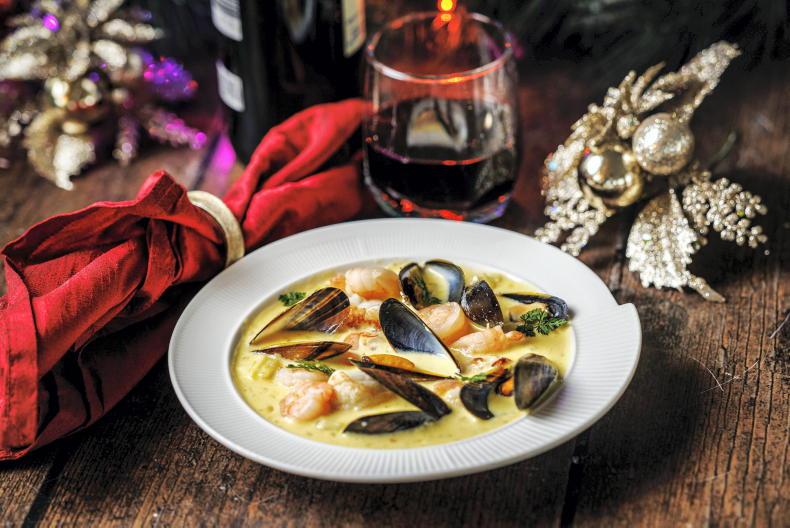
SHARING OPTIONS